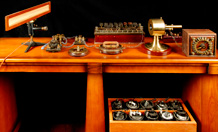
Mirror galvanometer and scale for receiving messages sent by submarine cable
Credit photograph: Cable & Wireless Archive courtesy of Porthcurno Telegraph Museum
History of Science in the South West
The submarine telegraph cable is one of the iconic technologies of the 19th century.
It enabled the British Empire to expand its business interests, communicate and manage its colonies around the globe.
Dr Richard Noakes, a historian at the University of Exeter’s Cornwall Campus is researching the role of commercial telegraphic firms, such as the Eastern Telegraph and Associated Companies (ETAC), whose long-distance underwater cable went out from Porthcurno, Cornwall, to countries around the world.
Dr Noakes' current research re-evaluates the British industrial approach to research and development in the Victorian period. He looks at how companies like the ETAC were involved in developing technical solutions to telegraphic problems.
The late 19th and early 20th century submarine telegraph business is often seen as being largely resistant to radical technological change. Historians generally believe that operators and manufacturers of cables saw improvement to cable design as being unnecessary and undesirable because of the longevity and cost of cables. The telegraph business was dominated by the ETAC, which faced weak competition and so had little incentive to develop new ways of delivering its service.
Through research at the Porthcurno Telegraph Museum., Dr Noakes has found that the ETAC developed a form of research and development which was more extensive than previously assumed. Even though its scale was dwarfed by that in American electrical firms, it established an in-house laboratory in 1902 and hired a strong team of scientific consultants from and electrical staff who worked on complex problems of cable signalling.
Dr Richard Noakes said: “The case of ETAC demonstrates the need for a more nuanced understanding of British industrial research and development. The ETAC focused on incremental improvements to existing technologies which was appropriate for a large service sector firms. It also sought to minimise the costs and risks associated with technological change.”
The research will be presented at The British Society for the History of Science (BSHS) annual conference at the University of Exeter, 14-17 July. The four-day international conference will explore all areas of historic scientific interest, from the practical means of finding longitude at sea to the transformation of agricultural technology and the development of the moving images. Dr Simon Naylor, Geographer from the University of Exeter’s Cornwall Campus will also be contributing to the conference by identifying the reasons why the British military and trading bodies established observatories overseas and observed weather during the travels and their expeditions.
The British Society for the History of Science (BSHS) will launch its online Travel Guide to visit places with ties to the history of science, technology and medicine including places like the Porthcurno Telegraph station. To mark the launch of the Travel Guide, and to celebrate its annual conference in Exeter, the BSHS has teamed up with the University of Exeter to produce a brochure about sites of scientific history in the Exeter.
University historian Dr Staffan Müller-Wille said: “The Exeter area is packed with past happenings in science, including medicine, technology and natural history, and thanks to this brochure visitors can be inspired to enjoy them all.”
"The campus of the University of Exeter, for example, is located on the former grounds of the Veitch family, one of Europe’s largest plant trading companies that sent its nursery men all around the world to hunt for new exotic plant species. Scientific knowledge and its applications have shaped our everyday life, and the landscapes we inhabit, and it is therefore important to know their history.”
Date: 14 July 2011
